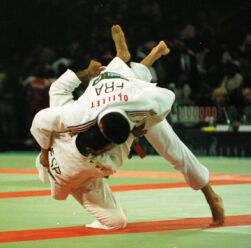Judo Origins - Bentleigh-Southern
Main menu:
- Home Page
- Why do judo?
- How to join
- Fees
- Class Times
- Contact Us
- Our instructing team
- Our Dojo
- Training At Our Club
- Latest Club Gradings
- About judo
- Yudansha (Black belts)
- Links To Judo Sites
- 2022 AGM
Judo Origins
Contact
Graeme Grogan
grogang1@gmail.com
0419 563 171
Helen
treasurer@southernjudo.org.au
0411 831 508


Judo had its origin in the ancient Japanese art of jujutsu, a system of hand-
Jujutsu has been known by several names throughout Japanese history: taijutsu, yawara, kempo, kugusoku, kumiuchi, koshinomawan. What is unique to the art is that one did not use brute strength to overpower an opponent, but rather skill, finesse and flexibility. Economy of energy, balance, and grace were the outstanding hallmarks of the good jujutsu practitioner. Unlike the Western hand-
In classical form, during the feudal period, jujutsu was part of the bushi training, along with archery, spearfighting, swordsmanship, horsemanship, manoeuvring, and etiquette. Its importance grew with the rise of the bushi class after the late Heian period. Throughout subsequent periods of Japanese history (Kamakura, 1185-
The schools differed in emphasis and strategy. Some specialized in throwing (nage), others in groundwork (osae, shime, kansetsu), and others in striking (atemi). In matters of strategy, some schools valued taking the initiative in combat while others preferred timely reaction to an opponent's aggression. Those that followed the principles of swordsmanship insisted on sudden, total attack. Others preferred to neutralize the opponent's attack once it was in motion.
Given the constant state of war in Japanese feudal history, ryus tested their vision of jujutsu on the battlefield, where the premium was on survival. The three hundred years of peace that followed the Japanese civil wars led to a change in the nature of the art. Under the harsh Tokugawa martial codes combats between bushi became rarer and heavy warfare far less frequent. On the other hand, unarmed combat became more common. The rise of the common citizen at the end of the period required that jujutsu techniques be adapted to the needs of everyday life.
At that time, several ryus lost their insistence on ceremonial or ritual posturing in favor of a more practical approach to hand-
During the Meiji Restoration after 1868, the transition from Bujutsu to Budo was completed. Several branches of the martial arts changed names and orientation entirely. Kyujutsu became Kyudo, iai-